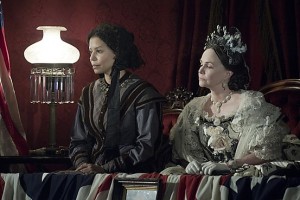This is the fourth in a weekly series of posts connecting Spielberg’s Lincoln to President Lincoln’s Cottage.
 (Image courtesy of Dreamworks)
(Image courtesy of Dreamworks)
A notable but perhaps overlooked element of Spielberg’s Lincoln is how it brings to life key individuals that worked as members of the White House household staff. The film draws our due attention to presidential valet William Slade, housekeeper Mary Anne Cuthbert, seamstress Elizabeth Keckley, and their respective relationships with the family. Staff members had significant roles in the Lincolns’ experience at the Cottage as well as at the Executive Mansion. We know from letters Matthew Pinsker interprets in his book, Lincoln’s Sanctuary: Abraham Lincoln and the Soldiers Home, that Slade and Cuthbert helped the First Family maintain order at their summer retreat.
If you have seen Lincoln, you may recall the scene in which Mr. Slade explains to a curious Tad that he was never enslaved, and rather was born free. Before his stewardship at the White House, Slade kept a local boardinghouse and worked as a messenger at the Treasury Department. According to former presidential speechwriter and author James C. Humes, when Lincoln practiced his speeches he often asked Slade to listen and share feedback on the delivery of certain lines.
Known to be disorganized, Lincoln left his notes and drafts helter-skelter in different rooms. Slade often collected these papers and filed them in the desk that currently stands in the White House’s ‘Lincoln Bedroom’ (a room in which Lincoln never actually slept—ahem. The reproduction that remains in the largest bedroom of the Cottage represents the careful decision making and writing Lincoln achieved there). In describing Slade, Pinsker looks to the memoir of his daughter, Nibbie. Nibbie wrote that her father said he could recite the Emancipation Proclamation from memory, having seen it in various draft stages. As a loyal companion and dedicated valet, Slade’s story at the Cottage is entwined into that of Lincoln’s.
Those who have watched Lincoln may remember when the eldest son Robert, just back from Harvard, bursts through a bustling White House corridor into the arms of his mother. The First Lady cries out over her shoulder, “Ms. Cuthbert! Bobby’s home!” Though Mary Anne Cuthbert does not physically appear in the film, the mention of her name serves as a nod to her importance in Lincoln family operations. An Irish immigrant, Cuthbert worked at the White House as a maid and housekeeper. Along with Slade, she accompanied the Lincolns on their three-and-a-half mile summertime trip north. On the cottage tour, visitors observe a reading of Lincoln’s letter to a travelling Mary Todd, in which he asks permission to move everyone back to the White House; Cuthbert and fellow staff member Aunt Mary had “grown cold.” Lincoln’s Sanctuary features more stories on Cuthbert and her involvement with the family.
Elizabeth Keckley was born enslaved in Dinwiddie, Virginia. As a girl she was transferred to Hillsboro, North Carolina, where she cared for her new masters’ infant. In Lincoln, Tad turns his attention from Slade to ask Keckley whether she was beaten while enslaved. Her on-screen retort is swift but poignant—“I was beaten with a fire shovel when I was younger than you were.” A passage from her gripping real-life memoir, Behind the Scenes: Formerly a Slave, but More Recently Modiste, and Friend to Mrs. Abraham Lincoln, speaks to this experience further: “My recollections of childhood are distinct, perhaps for the reason that many stirring incidents are associated with that period.”
Indeed, as she grew to become a young woman, Keckley endured unthinkable physical and emotional hardship. On an incident with an overseer named Mr. Bingham, she wrote in Behind the Scenes: “My spirit rebelled against the unjustness that had been inflicted upon me.” As Lincoln demonstrates, Keckley’s story turned out to be one of triumph. She worked for two years in St. Louis to purchase her and her son’s freedom.
After both were freed in 1855, Keckley continued to work, successfully repaid her patrons, and enrolled her in son Kirkland in Wilberforce University. In mid-1860 she moved to Washington, D.C. to establish herself as a seamstress. Once she found her footing, she attracted elite clients through word-of-mouth, including Mrs. Robert E. Lee. Keckley met Mary Lincoln in 1861, on the day of Lincoln’s first inauguration. The First Lady took a prompt liking to Keckley and hired her as a personal seamstress. Over the next six years two women grew close. Jennifer Fleischner’s book, Mrs. Lincoln and Mrs. Keckley, The Remarkable Story of the Friendship between a First Lady and a Former SlaveI, delves intimately into their relationship, suggesting that Keckley seems to be the right match for Mary’s strong personality. In fact, many agree that Lincoln could have showed a more thorough story of how Keckley exercised self-determination, civic activism, and agency.
That said Keckley, Slade, and Cuthbert give us further opportunity to connect the ideas and themes of the movie to those of the Cottage. At the Cottage we can explore Lincoln as a private man, spending time in his ‘private’ summer home. Keckley, Slade, and Cuthbert were indispensable figures in his and his family’s private life.
-Brittany Carney, Interpreter at President Lincoln’s Cottage
